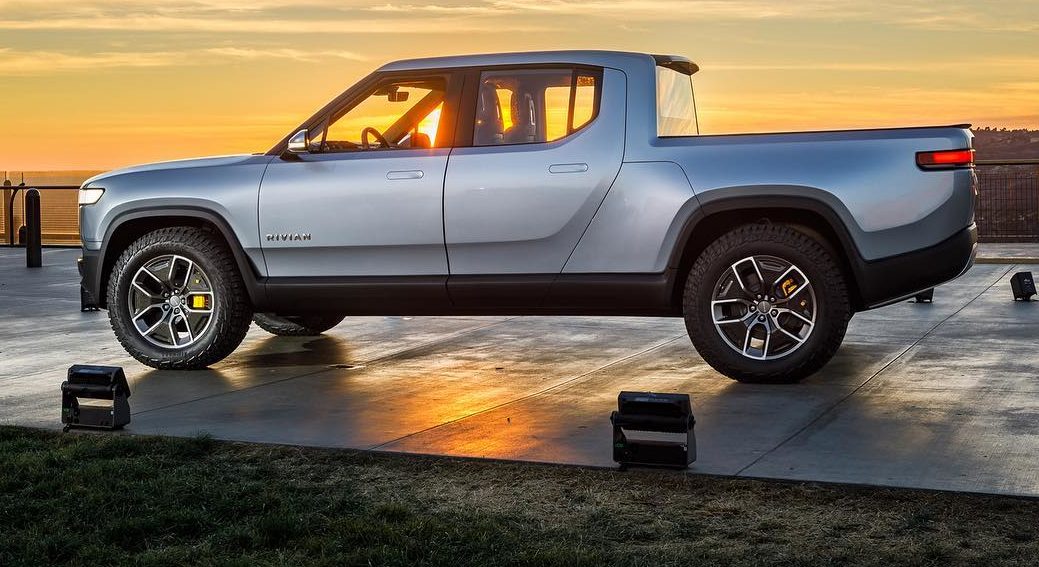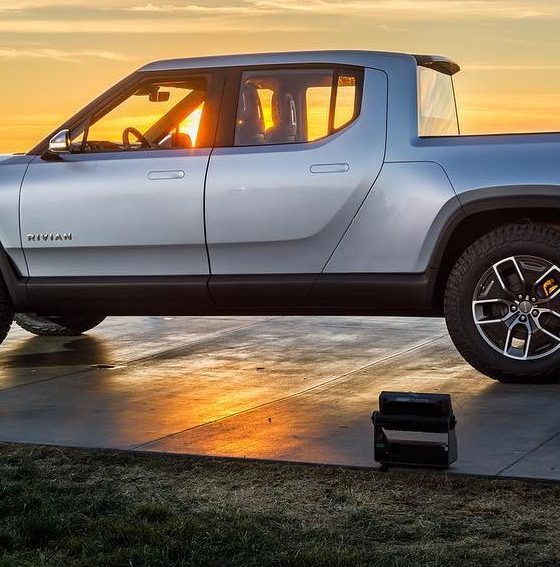

News
Rivian’s patent reveals electric truck’s ability to auto-adjust to removable modules
In a recently issued patent generically titled “Systems and Methods for Reconfigurable Electric Vehicles”, electric truck maker Rivian imagined a customizable driver experience wherein its cars feature both swappable module components and a computer system that adjusts the vehicle’s configurations to fit them. There’s even a potential business opportunity included with the functionality via the suggestion that vehicles and modules don’t need be to owned by the same people.
Planning a jet ski trip but don’t have the right cargo fitting on your SUV? Perhaps you could rent the right bed from a local Rivian module supplier where, after installation, your car will adjust its suspension and height after detecting what’s been installed. There’s a lot of imagination that can be poured into an electric car brand when users are free to customize their vehicles’ utility purpose however they see fit, and Rivian has captured just that in this method patent.
Easily swapping out major parts of a car kind of sounds like something an infomercial might pitch, but according to Rivian, it’s an unfulfilled need in the electric vehicle arena. As summarized by their patent (U.S. Patent No. 10,207,757), there are numerous uses for EVs that aren’t being tapped into because their configurations aren’t adjustable like fossil fuel-powered vehicles. Perhaps the aftermarket availability of numerous non-EV truck bed types, for instance, were part of this invention’s inspiration to create and offer modules for Rivian vehicles.

So, what exactly is a module in the Rivian sense? Perhaps the patent should speak for itself, per claim 28: “…wherein said different removable structural models include a removable recreation module; a removable delivery module; a removable open box utility module; a removable flat bed support module; and a removable side rail module.” The patent further notes that these modules would be attached to Rivian’s vehicles via latching mechanisms. Through these components, Rivian’s electric trucks can accomplish various tasks that would conventionally require multiple vehicle setups.
Rivian’s patent goes beyond just owner convenience and flexibility. In fact, one of the systems claimed is a business structure wherein module-swapping drivers don’t even own the trucks/SUVs but rather use their varied configuration cars on a rental basis. Maybe a delivery service could use the vehicles as needed, outfitted with modules appropriate for the size and shape of their haul. Or a business traveler could rent special configurations based on their particular trips’ needs.

Additionally, proposed data tracking capabilities could provide usage monitoring that would create preferential settings based on a renter’s history with the Rivian pool fleet. Things like braking sensitivity and ride firmness would be part of the customized customer experience using this data.
Although it’s only somewhat recently made its entry into the all-electric car manufacturing scene and won’t have production cars coming off the line until 2020, Rivian is already making waves with its clever innovations. Extra large battery packs with low centers of gravity and high ground clearance are expected to provide an impressive 400 miles of range with 200 horsepower available at each wheel, and smaller auxiliary packs that function like portable fuel tanks are anticipated to be available as well.
Since Rivian’s electric trucks are meant to be luxury adventure vehicles as well as modularized utility units (potentially), self-driving guided tours reminiscent of those in Jurassic Park are also on the feature list. The coming announcements certainly sound exciting, and for those ready to make the leap into ownership, Rivian has opened up reservations for both vehicles on its website, estimated to be in the $60,000 range after incentives.

News
Elon Musk’s Grokipedia surges to 5.6M articles, almost 79% of English Wikipedia
The explosive growth marks a major milestone for the AI-powered online encyclopedia, which was launched by Elon Musk’s xAI just months ago.

Elon Musk’s Grokipedia has grown to an impressive 5,615,201 articles as of today, closing in on 79% of the English Wikipedia’s current total of 7,119,376 articles.
The explosive growth marks a major milestone for the AI-powered online encyclopedia, which was launched by Elon Musk’s xAI just months ago. Needless to say, it would only be a matter of time before Grokipedia exceeds English Wikipedia in sheer volume.
Grokipedia’s rapid growth
xAI’s vision for Grokipedia emphasizes neutrality, while Grok’s reasoning capabilities allow for fast drafting and fact-checking. When Elon Musk announced the initiative in late September 2025, he noted that Grokipedia would be an improvement to Wikipedia because it would be designed to avoid bias.
At the time, Musk noted that Grokipedia “is a necessary step towards the xAI goal of understanding the Universe.”
Grokipedia was launched in late October, and while xAI was careful to list it only as Version 0.1 at the time, the online encyclopedia immediately earned praise. Wikipedia co-founder Larry Sanger highlighted the project’s innovative approach, noting how it leverages AI to fill knowledge gaps and enable rapid updates. Netizens also observed how Grokipedia tends to present articles in a more objective manner compared to Wikipedia, which is edited by humans.
Elon Musk’s ambitious plans
With 5,615,201 total articles, Grokipedia has now grown to almost 79% of English Wikipedia’s article base. This is incredibly quick, though Grokipedia remains text-only for now. xAI, for its part, has now updated the online encyclopedia’s iteration to v0.2.
Elon Musk has shared bold ideas for Grokipedia, including sending a record of the entire knowledge base to space as part of xAI’s mission to preserve and expand human understanding. At some point, Musk stated that Grokipedia will be renamed to Encyclopedia Galactica, and it will be sent to the cosmos.
“When Grokipedia is good enough (long way to go), we will change the name to Encyclopedia Galactica. It will be an open source distillation of all knowledge, including audio, images and video. Join xAI to help build the sci-fi version of the Library of Alexandria!” Musk wrote, adding in a later post that “Copies will be etched in stone and sent to the Moon, Mars and beyond. This time, it will not be lost.”
News
Tesla Model 3 becomes Netherlands’ best-selling used EV in 2025
More than one in ten second-hand electric cars sold in the country last year was a Tesla Model 3.

The Tesla Model 3 became the most popular used electric car in the Netherlands in 2025, cementing its dominance well beyond the country’s new-car market.
After years at the top of Dutch EV sales charts, the Model 3 now leads the country’s second-hand EV market by a wide margin, as record used-car purchases pushed electric vehicles further into the mainstream.
Model 3 takes a commanding lead
The Netherlands recorded more than 2.1 million used car sales last year, the highest level on record. Of those, roughly 4.8%, or about 102,000 vehicles, were electric. Within that growing segment, the Tesla Model 3 stood far ahead of its competitors.
In 2025 alone, 11,338 used Model 3s changed hands, giving the car an 11.1% share of the country’s entire used EV market. That means more than one in ten second-hand electric cars sold in the country last year was a Tesla Model 3, Auto Week Netherlands reported. The scale of its lead is striking: the gap between the Model 3 and the second-place finisher, the Volkswagen ID3, is more than 6,700 vehicles.
Rivals trail as residual values shape rankings
The Volkswagen ID.3 ranked a distant second, with 4,595 used units sold and a 4.5% market share. Close behind was the Audi e-tron, which placed third with 4,236 registrations. As noted by Auto Week Netherlands, relatively low residual values likely boosted the e-tron’s appeal in the used market, despite its higher original price.
Other strong performers included the Kia Niro, the Tesla Model Y, and the Hyundai Kona, highlighting continued demand for compact and midsize electric vehicles with proven range and reliability. No other model, however, came close to matching the Model 3’s scale or market presence.
News
Tesla Model Y Standard Long Range RWD launches in Europe
The update was announced by Tesla Europe & Middle East in a post on its official social media account on X.

Tesla has expanded the Model Y lineup in Europe with the introduction of the Standard Long Range RWD variant, which offers an impressive 657 km of WLTP range.
The update was announced by Tesla Europe & Middle East in a post on its official social media account on X.
Model Y Standard Long Range RWD Details
Tesla Europe & Middle East highlighted some of the Model Y Standard Long Range RWD’s most notable specs, from its 657 km of WLTP range to its 2,118 liters of cargo volume. More importantly, Tesla also noted that the newly released variant only consumes 12.7 kWh per 100 km, making it the most efficient Model Y to date.
The Model Y Standard provides a lower entry point for consumers who wish to enter the Tesla ecosystem at the lowest possible price. While the Model 3 Standard is still more affordable, some consumers might prefer the Model Y Standard due to its larger size and crossover form factor. The fact that the Model Y Standard is equipped with Tesla’s AI4 computer also makes it ready for FSD’s eventual rollout to the region.
Top Gear’s Model Y Standard review
Top Gear‘s recent review of the Tesla Model Y Standard highlighted some of the vehicle’s most notable features, such as its impressive real-world range, stellar infotainment system, and spacious interior. As per the publication, the Model Y Standard still retains a lot of what makes Tesla’s vehicles well-rounded, even if it’s been equipped with a simplified interior.
Top Gear compared the Model Y Standard to its rivals in the same segment. “The introduction of the Standard trim brings the Model Y in line with the entry price of most of its closest competition. In fact, it’s actually cheaper than a Peugeot e-3008 and costs £5k less than an entry-level Audi Q4 e-tron. It also makes the Ford Mustang Mach-E look a little short with its higher entry price and worse range,” the publication wrote.








